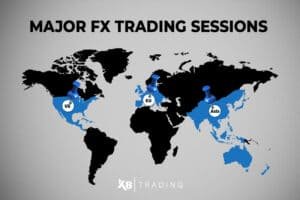Trading Sessions
Let’s take a look at some of the points we will be covering in this week’s blog:
- Understanding the different trading sessions
- When does volume increase?
- Are commodities and indices affected in the same way as forex pairs?

We can split the 24-hour foreign exchange market into three trading sessions;
- Asia session
- London session
- New York session
There will of course be overlaps in trading times, for example, the London open may be 08:00 BST and then the New York open at 13:00 BST, but this doesn’t mean that people in Europe stop trading at 13:00 BST. It allows us to develop an understanding of when we are likely to see an increase in volatility and when the assets we trade are more likely to make aggressive moves. The majority of trade occurs during the London and New York session. Therefore, we commonly see consolidation type price action during the Asia session. Let’s take a look at a recent example of $GBPJPY.
Even though this is a Yen pair we can clearly see the increased volatility of trade in the London and New York sessions. The green box highlights the New York session on 8th September 2021, the blue box highlights the overnight Asia session and finally the red box highlights the current price action we are seeing during the London open.

As I previously mentioned, we will have an overlap of trading sessions but for the most part we can use the following diagram to illustrate the different trading hours that we see in a 24-hour period rotation 5-days per week.
Times below are BST.

Therefore, the market opens on Sunday 22:00 BST and then shuts for the weekend at 22:00 BST on the Friday.
When does volume increase?
Using the above understanding of the trading sessions, the example of $GBPJPY and the knowledge that most volume is trading in the London and New York sessions we can establish that we are likely to see increased volume and volatility at around 08:00 and 13:00 BST. If you want to see this happen on a fairly extreme scale simply watch the DAX on a 1-minute or a 5-minute chart at 8am. As soon as the clock ticks from 07:59:59 to 08:00:00 you will notice an extremely sudden surge in volatile price action. This brings us on nicely to talk about other indices/ commodities and how they are affected by these trading sessions.
When looking at European indices it is fairly self-explanatory that they will see an increase in volume around the London open, the same can be said for indices such as the S&P500 around the New York open. But we still have small variations that it can be useful to be aware of. This relates back to when the markets were traded in the “pits”, indices and commodities had renowned “pit” trading hours and these still have a major influence on the markets today.
Let’s take a look at a few examples which nicely illustrate the small nuances and fluctuations between the markets. As I mentioned with the DAX seeing increased volatility at 08:00 BST, we can see similar occurrences with the S&P500 at 14:30 BST. When looking at Gold this occurs at 13:20 BST and the same with Crude Oil at 14:00 BST.
The hour before these “opens” are known as the initial balance for the commodity/ index and is associated to the “pit” trading hours that occurred in the past.
I hope you have found some use in the blog post this week; I personally think that developing your understanding of the markets you trade in this way is an important aspect to fully developing as a trader. When you have an understanding of why things occur it enables you to be more equipped to deal with different situations. The market is unpredictable enough, the least we can do is understand how it functions.
I hope you have found some use in this, until next week. Safe trading!
Jake

